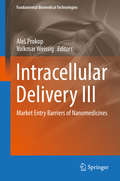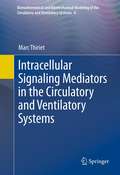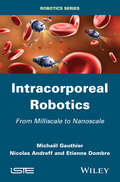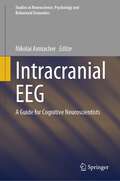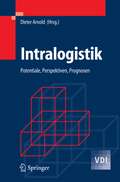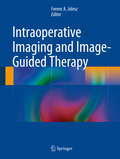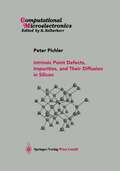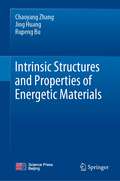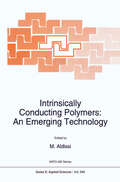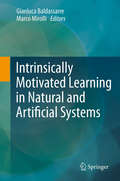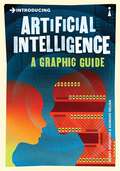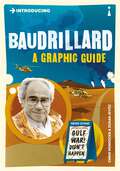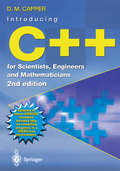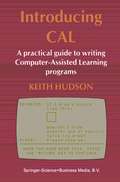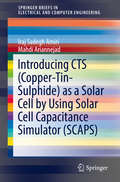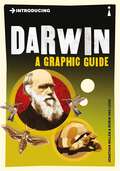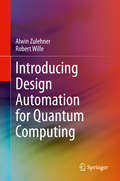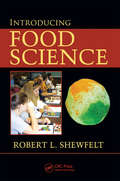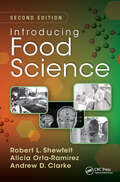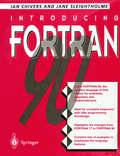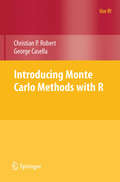- Table View
- List View
Intracellular Delivery III: Market Entry Barriers of Nanomedicines (Fundamental Biomedical Technologies #8)
by Aleš Prokop Volkmar WeissigA critical review is attempted to assess the status of nanomedicine entry onto the market. The emergence of new potential therapeutic entities such as DNA and RNA fragments requires that these new “drugs” will need to be delivered in a cell-and organelle-specific manner. Although efforts have been made over the last 50 years or so to develop such delivery technology, no effective and above all clinically approved protocol for cell-specific drug delivery in humans exists as yet. Various particles, macromolecules, liposomes and most recently “nanomaterials” have been said to “show promise” but none of these promises have so far been “reduced” to human clinical practice. The focus of this volume is on cancer indication since the majority of published research relates to this application; within that, we focus on solid tumors (solid malignancies). Our aim is critically to evaluate whether nanomaterials, both non-targeted and targeted to specific cells, could be of therapeutic benefit in clinical practice. The emphasis of this volume will be on pharmacokinetics (PK) and pharmacodynamics (PD) in animal and human studies. Apart from the case of exquisitely specific antibody-based drugs, the development of target-specific drug–carrier delivery systems has not yet been broadly successful at the clinical level. It can be argued that drugs generated using the conventional means of drug development (i.e., relying on facile biodistribution and activity after (preferably) oral administration) are not suitable for a target-specific delivery and would not benefit from such delivery even when a seemingly perfect delivery system is available. Therefore, successful development of site-selective drug delivery systems will need to include not only the development of suitable carriers, but also the development of drug entities that meet the required PK/PD profile.
Intracellular Signaling Mediators in the Circulatory and Ventilatory Systems (Biomathematical and Biomechanical Modeling of the Circulatory and Ventilatory Systems #4)
by Marc ThirietThe volumes in this authoritative series present a multidisciplinary approach to modeling and simulation of flows in the cardiovascular and ventilatory systems, especially multiscale modeling and coupled simulations. The cardiovascular and respiratory systems are tightly coupled, as their primary function is to supply oxygen to and remove carbon dioxide from the body's cells. Because physiological conduits have deformable and reactive walls, macroscopic flow behavior and prediction must be coupled to phenomenological models of nano- and microscopic events in a corrector scheme of regulated mechanisms when the vessel lumen caliber varies markedly. Therefore, investigation of flows of blood and air in physiological conduits requires an understanding of the biology, chemistry, and physics of these systems together with the mathematical tools to describe their functioning. Volume 4 is devoted to major sets of intracellular mediators that transmit signals upon stimulation of cell-surface receptors. Activation of signaling effectors triggers the release of substances stored in cellular organelles and/or gene transcription and protein synthesis. Complex stages of cell signaling can be studied using proper mathematical models, once the role of each component is carefully handled. Volume 4 also reviews various categories of cytosolic and/or nuclear mediators and illustrates some major signal transduction pathways, such as NFkappaB axis, oxygen sensing, and mechanotransduction.
Intracorporeal Robotics: From Milliscale to Nanoscale
by Michael Gauthier Nicolas Andreff Etienne DombreA promising long-term evolution of surgery relies on intracorporeal microrobotics. This book reviews the physical and methodological principles, and the scientific challenges to be tackled to design and control such robots. Three orders of magnitude will be considered, justified by the class of problems encountered and solutions implemented to manipulate objects and reach targets within the body: millimetric, sub-millimetric in the 10- 100 micrometer range, then in the 1-10 micrometer range. The most prominent devices and prototypes of the state of the art will be described to illustrate the benefit that can be expected for surgeons and patients. Future developments nanorobotics will also be discussed.
Intracorporeal Robotics: From Milliscale to Nanoscale
by Michael Gauthier Nicolas Andreff Etienne DombreA promising long-term evolution of surgery relies on intracorporeal microrobotics. This book reviews the physical and methodological principles, and the scientific challenges to be tackled to design and control such robots. Three orders of magnitude will be considered, justified by the class of problems encountered and solutions implemented to manipulate objects and reach targets within the body: millimetric, sub-millimetric in the 10- 100 micrometer range, then in the 1-10 micrometer range. The most prominent devices and prototypes of the state of the art will be described to illustrate the benefit that can be expected for surgeons and patients. Future developments nanorobotics will also be discussed.
Intracranial EEG: A Guide for Cognitive Neuroscientists (Studies in Neuroscience, Psychology and Behavioral Economics)
by Nikolai AxmacherThis book offers the first, comprehensive guide to planning and conducting intracranial EEG studies, and analyzing intracranial EEG data. The chapters address core questions in the field of intracranial EEG research. They are written by internationally recognized experts in the domain of intracranial EEG and acknowledge the heterogeneity of approaches in this field. The particular format of the book allows readers to find clear guidelines, hands-on expertise and invaluable background information for planning and conducting state-of-the-art intracranial EEG research projects. Besides offering a reference guide to newcomers in the field, it also provides scholarly information for the more experienced researcher and inspiration for the expert. The book covers a wide range of topics, with a special emphasis on aspects in which intracranial EEG data differ from other types of data in the cognitive neurosciences. It discusses typical patient characteristics and implantation schemes, ethical issues, and practical considerations for planning and running intracranial EEG experiments. It addresses signal characteristics and the physiological background of oscillatory and non-oscillatory aspects of intracranial EEG signals. It describes complex pre-processing steps such as advantages and disadvantages of different referencing schemes, and how to identify the location of electrodes. In addition, it answers specific questions on data processing, addressing core aspects of statistical analysis, and suggesting guidelines for data presentation. Further, it covers advanced topics such as causal interventions (i.e. deep brain stimulation), acquisition and analysis of single-unit data and multimodal recordings, and discusses important future challenges and opportunities in the field of intracranial EEG research.
Intralogistik: Potentiale, Perspektiven, Prognosen (VDI-Buch)
by Dieter ArnoldDie Intralogistik umfasst die Organisation, Steuerung, Durchführung und Optimierung des innerbetrieblichen Materialflusses, der Informationsströme sowie des Warenumschlags in Industrie, Handel und öffentlichen Einrichtungen. Die Aufgaben und Bedeutung der Intralogistik wird an Praxisbeispielen erläutert. Anerkannte Experten aus dem Kreise der Hersteller und Anwender sowie aus Forschung und Lehre beschreiben die Potentiale und die Perspektiven der Intralogistik und stellen ihre Prognosen zu den Entwicklungschancen in diesem Zukunftsmarkt zur Diskussion. Die Themen der Beiträge decken exemplarisch die ganze Breite der Intralogistik ab, aus strategischer, aus funktionaler und aus technischer Sicht informiert das Buch über den Stand und die Potentiale für gestalterische Kreativität in der Intralogistik.
Intraoperative Imaging and Image-Guided Therapy
by Ferenc A. JoleszImage-guided therapy (IGT) uses imaging to improve the localization and targeting of diseased tissue and to monitor and control treatments. During the past decade, image-guided surgeries and image-guided minimally invasive interventions have emerged as advances that can be used in place of traditional invasive approaches. Advanced imaging technologies such as magnetic resonance imaging (MRI), computed tomography (CT), and positron emission tomography (PET) entered into operating rooms and interventional suites to complement already-available routine imaging devices like X-ray and ultrasound. At the same time, navigational tools, computer-assisted surgery devices, and image-guided robots also became part of the revolution in interventional radiology suites and the operating room. Intraoperative Imaging and Image-Guided Therapy explores the fundamental, technical, and clinical aspects of state-of the-art image-guided therapies. It presents the basic concepts of image guidance, the technologies involved in therapy delivery, and the special requirements for the design and construction of image-guided operating rooms and interventional suites. It also covers future developments such as molecular imaging-guided surgeries and novel innovative therapies like MRI-guided focused ultrasound surgery. IGT is a multidisciplinary and multimodality field in which teams of physicians, physicists, engineers, and computer scientists collaborate in performing these interventions, an approach that is reflected in the organization of the book. Contributing authors include members of the National Center of Image-Guided Therapy program at Brigham and Women’s Hospital and international leaders in the field of IGT. The book includes coverage of these topics:- Imaging methods, guidance technologies, and the therapy delivery systems currently used or in development.- Clinical applications for IGT in various specialties such as neurosurgery, ear-nose-and-throat surgery, cardiovascular surgery, endoscopies, and orthopedic procedures. - Review and comparison of the clinical uses for IGT with conventional methods in terms of invasiveness, effectiveness, and outcome.- Requirements for the design and construction of image-guided operating rooms and interventional suites.
Intrinsic Point Defects, Impurities, and Their Diffusion in Silicon (Computational Microelectronics)
by Peter PichlerThis book contains the first comprehensive review of intrinsic point defects, impurities and their complexes in silicon. Besides compiling the structures, energetic properties, identified electrical levels and spectroscopic signatures, and the diffusion behaviour from investigations, it gives a comprehensive introduction into the relevant fundamental concepts.
Intrinsic Structures and Properties of Energetic Materials
by Chaoyang Zhang Jing Huang Rupeng BuThis book highlights the intrinsic structures of all kinds of energetic compounds and some structure–property relationships therein. Energetic materials are a class of energy materials that can transiently release a large amount of gases and heat by self-redox after stimulated and usually refer to explosives, propellants and pyrotechnics. Nowadays, in combination with various theories and simulation-aided material design technologies, many new kinds of energetic materials like energetic extended solids, energetic ionic salts, energetic metal organic frames, energetic co-crystals and energetic perovskites have been created, in addition to traditional energetic molecular crystals. It is somewhat dazzling, and an issue of how we can understand these new types of energetic materials is raised. In the past about 20 years, we were immersed in the computational energetic materials. By means of defining a concept of intrinsic structures of energetic materials, which refers to the crystal packing structure of energetic materials, as well as molecule for molecular solid specially, the microscopic structures have been mostly clarified, and related with many macroscopic properties and performances, with molecular simulations. This book presents our understanding about it. Thereby, a simply and new way to readily understand energetic materials is expected to be paved, based on this book. It contains energetic molecular crystals, energetic ionic crystals, energetic atomic crystals, energetic metallic crystals and energetic mixed-type crystals and the substructures closest to crystal packing. Meanwhile, the common intermolecular interactions in energetic crystals will be introduced. In addition, theoretical and simulation methods for treating the intrinsic structures will be briefed, as they are the main tools to reveal the molecules and crystals. Besides, the polymorphism as a level of intrinsic structures will be briefly discussed. In the final of this book, we introduce the crystal engineering of energetic materials. This book features the first proposal of intrinsic structure and crystal engineering of energetic materials and the understanding of the properties and performances of energetic materials by maintaining a concept that structure determines property. It helps to promote the rationality in creating new energetic materials, rather than increase experience.
Intrinsically Conducting Polymers: An Emerging Technology (NATO Science Series E: #246)
by M. AldissiThis book contains the majority of the papers presented at the NATO Ad vanced Research Workshop (ARW) held in Burlington, Vermont, USA on October 12-15, 1992. This ARW was the first of its kind to address the subject of intrinsically conducting polymers with an emphasis on processing and technological applications. The NATO ARW format was followed in that the subjects addressed here were limited in number but discussed in detail with the attendance being limited to a small number of selected scientists. The ARW brought together lecturers who are leaders in their respective fields from a wide range of NATO and non-NATO countries (a total of 11 countries) with the support of the NATO Scientific Affairs Division and some support from Champlain Cable Corporation. The total number of par ticipants was 33 and the number of presentations was 24. The speakers were chosen based on the topics selected for this workshop and repre sented industry, universities and government laboratories. The field of conducting polymers has grown rapidly during the past few years with important developments in materials processing and fabrica tion that brought about active research programs focusing on the use of these polymers as "smart" materials in technological applications and devices in academic and industrial research laboratories.
Intrinsically Motivated Learning in Natural and Artificial Systems
by Gianluca Baldassarre Marco MirolliIt has become clear to researchers in robotics and adaptive behaviour that current approaches are yielding systems with limited autonomy and capacity for self-improvement. To learn autonomously and in a cumulative fashion is one of the hallmarks of intelligence, and we know that higher mammals engage in exploratory activities that are not directed to pursue goals of immediate relevance for survival and reproduction but are instead driven by intrinsic motivations such as curiosity, interest in novel stimuli or surprising events, and interest in learning new behaviours. The adaptive value of such intrinsically motivated activities lies in the fact that they allow the cumulative acquisition of knowledge and skills that can be used later to accomplish fitness-enhancing goals. Intrinsic motivations continue during adulthood, and in humans they underlie lifelong learning, artistic creativity, and scientific discovery, while they are also the basis for processes that strongly affect human well-being, such as the sense of competence, self-determination, and self-esteem.This book has two aims: to present the state of the art in research on intrinsically motivated learning, and to identify the related scientific and technological open challenges and most promising research directions. The book introduces the concept of intrinsic motivation in artificial systems, reviews the relevant literature, offers insights from the neural and behavioural sciences, and presents novel tools for research. The book is organized into six parts: the chapters in Part I give general overviews on the concept of intrinsic motivations, their function, and possible mechanisms for implementing them; Parts II, III, and IV focus on three classes of intrinsic motivation mechanisms, those based on predictors, on novelty, and on competence; Part V discusses mechanisms that are complementary to intrinsic motivations; and Part VI introduces tools and experimental frameworks for investigating intrinsic motivations.The contributing authors are among the pioneers carrying out fundamental work on this topic, drawn from related disciplines such as artificial intelligence, robotics, artificial life, evolution, machine learning, developmental psychology, cognitive science, and neuroscience. The book will be of value to graduate students and academic researchers in these domains, and to engineers engaged with the design of autonomous, adaptive robots.The contributing authors are among the pioneers carrying out fundamental work on this topic, drawn from related disciplines such as artificial intelligence, robotics, artificial life, evolution, machine learning, developmental psychology, cognitive science, and neuroscience. The book will be of value to graduate students and academic researchers in these domains, and to engineers engaged with the design of autonomous, adaptive robots.
Intrinsische Hybridverbunde für Leichtbautragstrukturen: Grundlagen der Fertigung, Charakterisierung und Auslegung
by Jürgen FleischerDer Einsatz von Leichtbautragstrukturen bietet heutzutage die Möglichkeit eine signifikante Gewichtsreduzierung zu realisieren. Bei der Gestaltung dieser Leichtbautragstrukturen müssen, je nach Anwendungsfall, eine Vielzahl von Anforderungen berücksichtigt werden. Die komplette Substitution eines Werkstoffes ist für die konsequente Nutzung des Leichtbaupotentials nicht immer zielführend. Eine optimale Gesamtstruktur besteht aus einer hybriden Werkstoffkombination, dem sogenannten Multi-Material-Design. Der Ansatz der Hybridisierung von Strukturkomponenten rückt somit immer stärker in den Vordergrund und kann grundsätzlich nach zwei unterschiedlichen Methoden erfolgen. Zum einen können zwei Bauteile aus Faserverbundkunststoff und Metall durch nachgeschaltete Fügeprozesse, wie beispielsweise Nieten, Schrauben oder Kleben, gefügt werden. Nachteil dieses Ansatzes ist neben dem Aufwand für den Fügeprozess die zusätzliche Masse, durch die das Leichtbaupotential nicht vollkommen ausgeschöpft werden kann. Zum anderen besteht die Möglichkeit der Herstellung des Hybridverbunds in einem einstufigen Prozess, wobei die Verbindung der verschiedenen Materialien im Ur- oder Umformprozess ohne einen nachfolgenden Fügeschritt erfolgt. Das entstehende Bauteil dieses einstufigen Prozesses wird als intrinsisches Hybrid bezeichnet. Aufgrund der intrinsischen Hybridisierung entstehen neue Gestaltungsmöglichkeiten und produktionstechnische Vorteile, aber auch Herausforderungen in Bezug auf die Prüfung, Simulation und Herstellung. Im Rahmen des Schwerpunktprogramms 1712 der Deutschen Forschungsgemeinschaft wurde hierzu auf den Fachgebieten Produktionstechnik, Mechanik und Werkstoffwissenschaften intensiv Forschungsarbeit geleistet.
Introducing Artificial Intelligence: A Graphic Guide (Introducing...)
by Henry BrightonHalf a century of research has resulted in machines capable of beating the best human chess players, and humanoid robots that can interact. But can machines really think? Is the mind just a complicated computer program? Introducing Artificial Intelligence focuses on the issues behind one of science's most difficult problems.
Introducing Baudrillard: A Graphic Guide (Introducing...)
by Chris HorrocksIllustrated guide to the controversial sociologist Jean Baudrillard, who died in 2007. Did the Gulf War take place? Is it possible to fake a bank robbery? Was sexual liberation a disaster? Jean Baudrillard has been hailed as one of France's most subtle and powerful theorists. But his provocative style and assaults on sociology, feminism and Marxism have exposed him to accusations of promoting a dangerous new orthodoxy - of being the 'pimp' of postmodernism. Introducing Baudrillard cuts beneath the controversy of this misunderstood intellectual to present his radical claims that reality has been replaced by a simulated world of images and events ranging from TV news to Disneyland. It provides a clear account of Baudrillard's work on obesity, pornography and terrorism and traces his development from critic of mass consumption to prophet of the apocalypse. Chris Horrocks' text and Zoran Jevtic?s artwork invite us to decide whether Baudrillard was a cure for the vertigo of contemporary culture - or one of its symptoms
Introducing C++ for Scientists, Engineers and Mathematicians
by Derek CapperWritten especially for scientists, engineers and mathematicians, this book has been extensively updated and revised to conform to the 1998 ANSI/ISO C++ Standard. It now includes all the recent developments in C++ . Amongst its novel features is that no knowledge of programming is assumed. It is as much for the beginner in programming as it is for the newcomer to C++. Plenty of relevant examples are included throughout the book, most of which are slanted towards numerical applications, and it is this bias that makes it unique in its field and of particular interest to those who have to work with figures.
Introducing CAL: A practical guide to writing Computer-Assisted Learning programs
by Keith HudsonIt is often the case - perhaps more often than not - that new ideas arrive long before there is the me ans to clothe and deli ver them. We can think ofLeonardo da Vinci's drawings of helicopters and submarines among many other examples. Computer-Assisted Learning (CAL) is an example of an idea which has had a particularly long gestation. As I will illustrate early in the book, the principles of CAL were really first discovered by Socrates. As a formal method of teaching, the Socratic method disappeared for over two millennia until the 1950s. It was then revived in the form ofProgrammed Learning (PL) which resulted from the researches ofB. F. Skinner at Harvard University. Even then, PL was premature. In the 1950s and 60s, methods were devised, such as teaching machines and various sorts ofPL text books, and there was a mushrooming of PL publishing at that time. For a complex of reason- economic, logistical and technical-PL also largely disappeared from the mid- 60s, although it continued in a few specialized areas ofteaching and industrial training. However, during the same period, PL quietly transformed itselfinto CAL. But the computerized form was not capable of mass dissemination until recently hecause personal microcomputers did not have sufficient internal memory sizes. That situation has now changed very dramatically and 128K microcomputers are becoming cheap and widely available. Cheap memory chips of256K and 1024K cannot be far away, either.
Introducing CTS (SpringerBriefs in Electrical and Computer Engineering)
by Iraj Sadegh Amiri Mahdi AriannejadThis book discusses the enhancement of efficiency in currently used solar cells. The authors have characterized different structures of the solar cell system to optimize system parameters, particularly the performance of the Copper-Tin-Sulphide solar cell using Solar Cell Capacitance Simulator (SCAPS). This research can help scientist to overcome the current limitations and build up new designs of the system with higher efficiency and greater functionality. The authors have investigated the corresponding samples from various viewpoints, including structural (crystallinity, composition and surface morphology), optical (UV–vis–near-IR transmittance/reflectance spectra) and electrical resistivity properties. Describes investigations on Cu2SnS3 solar cells and prospective low cost absorber layer of thin film solar cells;Discusses the potential device structure of Copper-Tin-Sulphide based on thin film technologies;Explains solar cell structure optimization to perform a higher conversion efficiency of Copper-Tin-Sulphide.
Introducing Darwin: A Graphic Guide (Introducing...)
by Jonathan MillerProgress in genetics today would not be possible without Darwin's revolution, but the mysterious man who laid the rational basis for undermining belief in God's creation was remarkable timid. He spent most of his life in seclusion; a semi-invalid, riddled with doubts, fearing the controversy his theories might unleash. In this brilliantly lucid book - a classic originally published in 1982 - Jonathan Miller unravels Darwin's life and his contribution to biology, and traces the path from his scientific predecessors to the later modifications that his own evolutionary theories required. Introducing Darwin brings alive the difficult progress from pre-Darwinian thinking to modern genetics and the devastatingly important impact of one man on our fundamental understanding of biology, life and ourselves.
Introducing Design Automation for Quantum Computing
by Alwin Zulehner Robert WilleThis book offers readers an easy introduction into quantum computing as well as into the design for corresponding devices. The authors cover several design tasks which are important for quantum computing and introduce corresponding solutions. A special feature of the book is that those tasks and solutions are explicitly discussed from a design automation perspective, i.e., utilizing clever algorithms and data structures which have been developed by the design automation community for conventional logic (i.e., for electronic devices and systems) and are now applied for this new technology. By this, relevant design tasks can be conducted in a much more efficient fashion than before – leading to improvements of several orders of magnitude (with respect to runtime and other design objectives).Describes the current state of the art for designing quantum circuits, for simulating them, and for mapping them to real hardware;Provides a first comprehensive introduction into design automation for quantum computing that tackles practically relevant tasks;Targets the quantum computing community as well as the design automation community, showing both perspectives to quantum computing, and what impressive improvements are possible when combining the knowledge of both communities.
Introducing Food Science
by Robert L. ShewfeltAs daily consumers of foods and beverages, everyone has opinions and interests about their diet choices. However, many questions about food are often non-technical and, therefore, defy technical answers. Introducing Food Science addresses a range of food issues facing today's consumer, proceeding from a general and student-friendly discussion to an
Introducing Food Science
by Robert L. Shewfelt Andrew D. Clarke Alicia Orta-RamirezWritten as an introductory food science textbook that excites students and fosters learning, the first edition of Introducing Food Science broke new ground. With an easy-to-read format and innovative sections such as Looking Back, Remember This!, and Looking Ahead, it quickly became popular with students and professors alike. This newly r
Introducing Food Science
by Robert L. Shewfelt Andrew D. Clarke Alicia Orta-RamirezWritten as an introductory food science textbook that excites students and fosters learning, the first edition of Introducing Food Science broke new ground. With an easy-to-read format and innovative sections such as Looking Back, Remember This!, and Looking Ahead, it quickly became popular with students and professors alike. This newly r
Introducing Fortran 90
by Ian D. Chivers Jane SleightholmeThis book has evolved from our combined experience of working in computing services at the University of London (for the last nine years at King's College, and before that eight years at Imperial College and seven at Chelsea College) in the teaching, advice and technical support of Fortran and related areas. Thanks are due to:- • the staff and students at King's College London - without them none of this would have been possible; also the support and facilities provided by the Computer Centre; • the patience of our families during the lengthy period required to develop the courses upon which this book is based and whilst preparing the camera ready copy; • the staff at NAG, Salford Fortran and DEC for their support. Special thanks to Steve Lionel at DEC and Tim Bartle at Salford for the opportunity to take part in the beta testing of the Alpha compiler and the Salford Nag compiler respectively. The lessons to be learnt from moving programs between the three compilers were invaluable; • the people on comp. lang. fortran and the specialist Fortran 90 list.
Introducing Molecular Electronics (Lecture Notes in Physics #680)
by Gianaurelio Cuniberti Giorgos Fagas Klaus RichterKlaus von Klitzing Max-Planck-Institut fur ¨ Festk¨ orperforschung, Heisenbergstraße 1, 70569 Stuttgart, Germany Already many Cassandras have prematurely announced the end of the silicon roadmap and yet, conventional semiconductor-based transistors have been continuously shrinking at a pace which has brought us to nowadays cheap and powerful microelectronics. However it is clear that the traditional scaling laws cannot be applied if unwanted tunnel phenomena or ballistic transport dominate the device properties. It is generally expected, that a combination of silicon CMOS devices with molecular structure will dominate the ?eld of nanoelectronics in 20 years. The visionary ideas of atomic- or molecular-scale electronics already date back thirty years but only recently advanced nanotechnology, including e.g. scanning tunneling methods and mechanically controllable break junctions, have enabled to make distinct progress in this direction. On the level of f- damentalresearch,stateofthearttechniquesallowtomanipulate,imageand probechargetransportthroughuni-molecularsystemsinanincreasinglyc- trolled way. Hence, molecular electronics is reaching a stage of trustable and reproducible experiments. This has lead to a variety of physical and chemical phenomena recently observed for charge currents owing through molecular junctions, posing new challenges to theory. As a result a still increasing n- ber of open questions determines the future agenda in this ?eld.
Introducing Monte Carlo Methods with R (Use R!)
by Christian Robert George CasellaComputational techniques based on simulation have now become an essential part of the statistician's toolbox. It is thus crucial to provide statisticians with a practical understanding of those methods, and there is no better way to develop intuition and skills for simulation than to use simulation to solve statistical problems. Introducing Monte Carlo Methods with R covers the main tools used in statistical simulation from a programmer's point of view, explaining the R implementation of each simulation technique and providing the output for better understanding and comparison. While this book constitutes a comprehensive treatment of simulation methods, the theoretical justification of those methods has been considerably reduced, compared with Robert and Casella (2004). Similarly, the more exploratory and less stable solutions are not covered here. This book does not require a preliminary exposure to the R programming language or to Monte Carlo methods, nor an advanced mathematical background. While many examples are set within a Bayesian framework, advanced expertise in Bayesian statistics is not required. The book covers basic random generation algorithms, Monte Carlo techniques for integration and optimization, convergence diagnoses, Markov chain Monte Carlo methods, including Metropolis {Hastings and Gibbs algorithms, and adaptive algorithms. All chapters include exercises and all R programs are available as an R package called mcsm. The book appeals to anyone with a practical interest in simulation methods but no previous exposure. It is meant to be useful for students and practitioners in areas such as statistics, signal processing, communications engineering, control theory, econometrics, finance and more. The programming parts are introduced progressively to be accessible to any reader.
